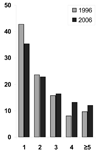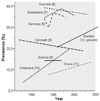Major increase in allergic sensitization in schoolchildren from 1996 to 2006 in northern Sweden
- PMID: 19577282
- PMCID: PMC2747664
- DOI: 10.1016/j.jaci.2009.05.011
Major increase in allergic sensitization in schoolchildren from 1996 to 2006 in northern Sweden
Abstract
Background: Time trends for allergic sensitization are poorly known.
Objective: To compare the trends in prevalence of allergic sensitization and associated risk factors in children.
Methods: Two cohorts of children (age 7-8 years) were invited for skin prick tests (SPTs) 10 years apart, 1996 and 2006. The participation rates were 2148 (88%) and 1700 (90%), respectively. The methods were identical, and 10 common airborne allergens were used. An expanded International Study of Allergy and Asthma in Children questionnaire about symptoms and possible risk factors for allergic conditions was completed by the parents.
Results: The prevalence of any positive SPT increased from 21% in 1996 to 30% in 2006 (P < .001). The pattern of sensitization remained similar, and sensitization to cat was most common both years, 13% and 19%, respectively. Sensitization to mites and mold was uncommon in both surveys. A family history of allergy was a significant risk factor for a positive SPT both years (odds ratio, 1.7). Factors that in 1996 had a protective effect, such as rural living and having several siblings, had lost this effect in 2006. The prevalence of most risk factors remained similar, but respiratory infections and smoking among parents decreased significantly. During the same period, there was no significant increase in the prevalence of current wheeze (11.9% to 12.4%, P = .636) or symptoms of rhinitis or eczema.
Conclusion: The prevalence of allergic sensitization increased significantly from 1996 to 2006, whereas no increase in clinical symptoms was found. The parallel decrease in parental smoking and respiratory infections indicate a different influence of environmental factors on allergic sensitization and clinical symptoms, respectively.
Conflict of interest statement
Figures



References
-
- Eder W, Ege MJ, von Mutius E. The asthma epidemic. N England J Med. 2006;355:2226–2235. - PubMed
-
- Asher MI, Montefort S, Bjorksten B, Lai CK, Strachan DP, Weiland SK, et al. ISAAC Phase Three Study Group. Worldwide time trends in the prevalence of symptoms of asthma, allergic rhinoconjunctivitis, and eczema in childhood: ISAAC Phases One and Three repeat multicountry cross-sectional surveys. Lancet. 2006;368:733–743. - PubMed
Publication types
MeSH terms
Substances
Grants and funding
LinkOut - more resources
Full Text Sources
Medical
Miscellaneous

